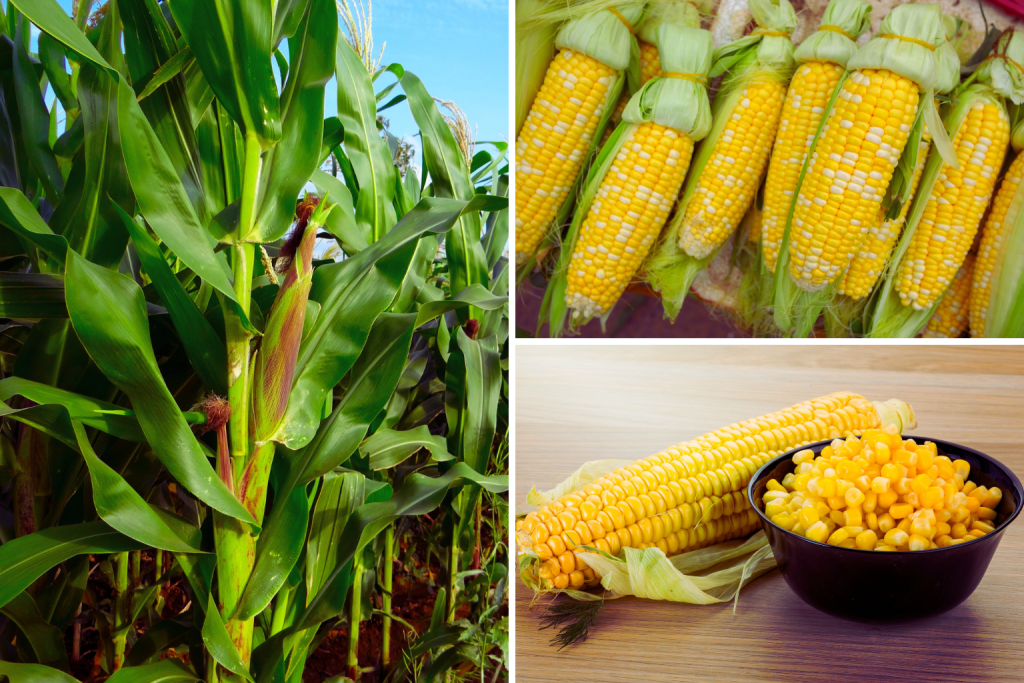
Sweet Corn (Zea mays)
-
Common Name: Sweet Corn
-
Scientific Name: Zea mays var. saccharata
-
Family: Poaceae
-
Origin: Southern Mexico
-
Zone Hardiness: USDA Zones 3a–11b
-
Light Requirements: Full sun (6–8 hours daily)
-
Water Needs: High; requires 1–1.5 inches (2.5–3.8 cm) per week, especially during tasseling and ear development
-
Soil Preferences: Prefers fertile, well-drained loamy soil with a pH between 6.0 and 6.8
-
"Ponics" Compatibility:
• Aquaponics: Not compatible
• Aeroponics: Not compatible
• Hydroponics: Not compatible
• Preferred Method: Not applicable -
Growth Habit: Upright annual grass
-
Height & Spread: Height: 6–8 feet (1.8–2.4 meters); Spread: 1–2 feet (30–60 cm)
-
Time from Germination to Harvest: 60–100 days, depending on variety
-
Flowering Time: Mid to late summer
-
Edible Parts: Kernels (seeds)
-
Medicinal Uses: Corn silk has been used traditionally as a diuretic and for urinary tract health
-
Companion Plants: Beans, squash, cucumbers, melons, peas, pumpkins, sunflowers, dill, marigolds
-
Pest & Disease Resistance:
• Susceptible to corn earworm, aphids, and fungal diseases
• Companion planting and crop rotation can help mitigate pest issues -
Harvest Time: Harvest when silks turn brown and kernels exude a milky liquid when punctured; best consumed fresh or can be blanched and frozen for long-term storage
-
Propagation Methods: Propagated by seed; sow seeds directly into warm soil (above 60°F/15.5°C); seeds germinate in 7–10 days
-
Sustainability Features: Provides structural support in companion planting (e.g., "Three Sisters" method); attracts beneficial insects; contributes to soil health through biomass
-
Culinary Uses: Eaten fresh (on the cob), boiled, grilled, or steamed; kernels used in soups, salads, salsas, and baked goods; can be processed into cornmeal or corn syrup
-
Fun Fact: An average ear of corn has about 800 kernels arranged in 16 rows
Specific Varieties
Silver Queen (SU)
Flavor Profile: Very sweet, tender, snow-white kernels.
Culinary Uses: Ideal for fresh consumption, freezing, and canning.
Notes: Late-season variety; matures in 92 days; plants reach 8 feet tall.
Kandy Korn (SE)
Flavor Profile: Sweet and tender, golden-yellow kernels.
Culinary Uses: Excellent for freezing and canning.
Notes: Matures in 89 days; stalks grow 8–9 feet tall; adapts to a wide range of climates.
Ruby Queen (SE)
Flavor Profile: Exceptionally sweet, deep red kernels.
Culinary Uses: Best steamed or microwaved to preserve color and flavor.
Notes: Matures in 75 days; stalks reach 7 feet tall; visually striking with red tassels and stalks.
Peaches and Cream (SE)
Flavor Profile: Sweet and tender with bi-color kernels.
Culinary Uses: Suitable for fresh eating, freezing, and canning.
Notes: Matures in 70 days; plants grow to 6 feet tall; ears average 8 inches with 18–20 rows of kernels.
Illini Xtra Sweet (SH2)
Flavor Profile: Extremely sweet, golden-yellow kernels.
Culinary Uses: Excellent for fresh consumption and freezing.
Notes: Matures in 85 days; plants reach 6½ feet tall; requires isolation from other corn types to maintain sweetness.
Ambrosia (SE)
Flavor Profile: Plump and sweet with white and yellow kernels.
Culinary Uses: Ideal for fresh consumption, freezing, and canning.
Notes: Matures in 75 days; plants average 6.5 feet tall; ears are 8 inches long with 14 rows of kernels.
Golden Bantam (Heirloom, SU)
Flavor Profile: Sweet with an old-fashioned corn flavor.
Culinary Uses: Suitable for fresh eating and canning.
Notes: Introduced in 1902; matures in 80 days; plants average 5 feet tall; ears are 6 inches long with 12–14 rows of yellow kernels.
Honey Select (SE)
Flavor Profile: Sweet, tender yellow kernels.
Culinary Uses: Ideal for fresh eating, freezing, and canning.
Notes: Matures in 79 days; plants grow to 7 feet tall; ears are 8 inches long with 16–18 rows of kernels.
Country Gentleman (Heirloom, SU)
Flavor Profile: Creamy white kernels with a sweet flavor.
Culinary Uses: Excellent for roasting and canning.
Notes: Known as "shoepeg corn"; kernels are irregularly spaced; matures in 90 days; plants reach 8 feet tall.
Early Sunglow (SU)
Flavor Profile: Sweet yellow kernels.
Culinary Uses: Good for fresh consumption and freezing.
Notes: Matures in 63 days; plants average 4.5 feet tall; ears are 7 inches long with 12 rows of kernels; suitable for cooler climates.
Bodacious (SE)
Flavor Profile: Very sweet and juicy golden-yellow kernels.
Culinary Uses: Excellent for fresh consumption, freezing, and canning.
Notes: Matures in 75 days; plants average 7 feet tall; ears are 8 inches long with 18 rows of kernels; good disease resistance.
Sugar Buns (SE)
Flavor Profile: Plump and sweet golden-yellow kernels.
Culinary Uses: Suitable for fresh eating, freezing, and canning.
Notes: Matures in 72 days; plants average 6.5 feet tall; ears are 7 inches long with 18 rows of kernels; moderate disease resistance.
Quickie (SE)
Flavor Profile: Sweet with white and pale yellow kernels.
Culinary Uses: Good for fresh consumption and freezing.
Notes: Matures in 68 days; plants average 5 feet tall; ears are 7 inches long with 12–14 rows of kernels; suitable for cool climates.
Avalon (SE)
Flavor Profile: Sweet white kernels.
Culinary Uses: Ideal for fresh eating, freezing, and canning.
Notes: Matures in 82 days; ears are 8 inches long with 16 rows of kernels; plants grow to 6 feet tall.
Jubilee (SU)
Flavor Profile: Sweet, tender yellow kernels.
Culinary Uses: Excellent for fresh eating and processing.
Notes: Matures in 83 days; plants grow to 7–7.5 feet tall; ears are 8–9 inches long with 16 rows of kernels; resists smog and smut.
Butter and Sugar (SU)
Flavor Profile: Good flavor with bicolor white and yellow kernels.
Culinary Uses: Ideal for fresh consumption.
Notes: Matures in 73 days; ears are 7–8 inches long; resists bacterial wilt and southern corn leaf blight.
How Sweet It Is (SE)
Flavor Profile: Sweet, crisp, tender white kernels.
Culinary Uses: Suitable for fresh eating and storage.
Notes: Matures in 87 days; ears are 8 inches long with 18–22 rows of kernels; plants grow to 6.5 feet tall; All-America Selections winner; resists most diseases.
Sweetie (SH2)
Flavor Profile: Exceptionally sweet, tender, and crisp deep golden-yellow kernels.
Culinary Uses: Excellent for fresh consumption and storage.
Notes: Matures in 82 days; ears are 7–8 inches long with 14–18 rows of kernels; plants grow to 6 feet tall; retains sweetness for a long period; 30% fewer calories than regular corn.
Early Xtra Sweet (SH2)
Flavor Profile: Extra sweet golden-yellow kernels.
Culinary Uses: Ideal for fresh eating.
Notes: Matures in 71 days; ears are 7–9 inches long with 12–16 rows of kernels; plants grow to 5–6 feet tall; All-America Selections winner; resists most diseases.
Butterfruit Original Early (SH2)
Flavor Profile: Bright yellow kernels with a savory flavor.
Culinary Uses: Suitable for fresh consumption.
Notes: Matures in 72 days; ears are tightly packed; plants grow to 5 feet tall; matures extra early.
Early Golden Bantam (SU)
Flavor Profile: Sweet yellow kernels.
Culinary Uses: Ideal for fresh eating.
Notes: Introduced in 1902; matures in 80 days; heirloom variety.
Understanding Sweet Corn Types:
-
SU (Standard Sweet): The traditional sweet corn type. It has a classic corn flavor but should be eaten soon after harvest, as it quickly loses its sweetness. Varieties like 'Golden Bantam' and 'Silver Queen' fall into this category.
-
SE (Sugary Enhanced): Offers more sweetness and tenderness than SU types and holds its flavor longer after harvest. Ideal for home gardens and fresh eating. Examples include 'Ambrosia' and 'Peaches and Cream'.
-
SH2 (Super Sweet or Shrunken-2): These are the sweetest corn varieties with excellent storage life. They require isolation from other types to prevent cross-pollination that could reduce quality. Examples include 'Sweetie' and 'Early Xtra Sweet'.
Wrapping Up Your Journey Towards Off-Grid Living
Remember the Importance of Simplifying Life
As you consider the pros, cons, and various options related to transitioning to an off-grid lifestyle, keep in mind that the ultimate goal is to simplify your life. Achieving this simplification can lead to significantly reduced stress and clutter, helping you create a more peaceful and fulfilling daily experience.
If you feel the need to revisit any part of this lesson, please do so to ensure you have a clear understanding of all aspects involved. Additionally, don’t hesitate to explore the other lessons in this course to deepen your knowledge and support your journey toward a more intentional and simplified way of living.
Audio
Video
